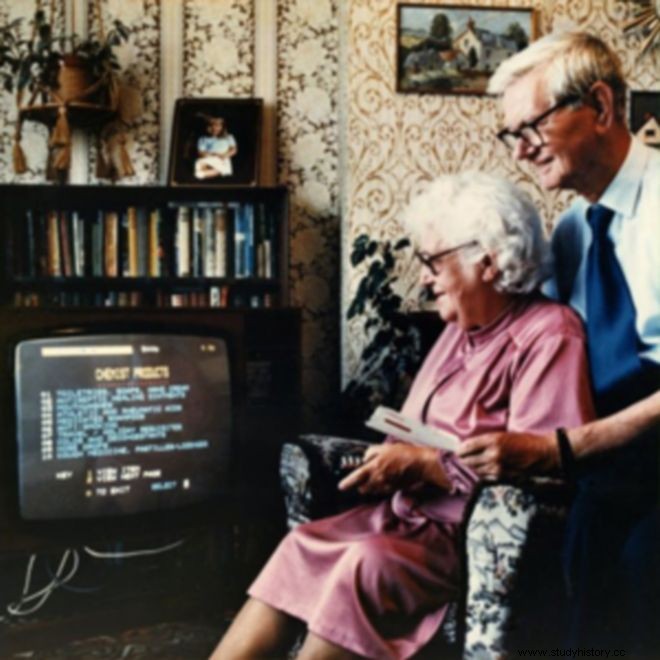As December approaches each year, the media around the world focus on the subject of the essay you were asked to write every year of your life as a primary school student - after how you spent your summer. As the year had already turned its back on you and was about to close the exit door, you took a look back to figure out what you're keeping and what you're letting go. And of course, to justify.
Back to the media, everything you saw until this year in the last days of December, as a 'review' was the product of months of work. This year it turned out to be quite a few hours, since most of the 'events of the year' revolved around Covid-19. One was the evolution of online shopping into a dominant hobby, worldwide. We owe this possibility somewhere. Not to learn who to light a candle or curse - depending on how each one of us now handles the 'world' that opened before us?

41 years ago , in 1979 the then 38-year-old inventor and entrepreneur Michael Aldrich , who operated in Great Britain had succeeded in connecting a modified home appliance to a computer to manage/process real-time transactions over a telephone line. He called the result 'teleshopping'. Today we call it online shopping, eCommerce and e-business. Markets that are now worth billions.
As he himself wrote, "in early 1979, a 26-inch color television arrived at my office at the Rediffusion Group where I worked. It was accompanied by a note. Those who had made the shipment were asking for my opinion on the product. My company he also built televisions and we often checked out the prototypes. Except that televisions weren't a priority for the Rediffusion Group - computers for businesses were - so I let the television sit in a corner for a while. At some point I was informed that it was going to for a new model designed to accommodate a new Post Office service, called Prestel, which would be provided for a fee.
It was something like teletext with the information being transmitted over a telephone line, instead of a television signal - as was the case until then. My partners and I started to study the idea, but we couldn't figure out how to make money from this new product. I considered it unnecessary even to turn on the device that remained in the corner. One day, one of our technicians asked me if he could open the package and finally see what was inside. I told him 'go ahead'. A few weeks later he told me that he had found a chip set and a chip modem, a character 'generator' and an automatic dialing program for four numbers. I realized that it was enough to connect one of our computers to this TV, to have Prestel".
He did not continue, however, to investigate or test.
In the summer of 1979 on a walk with his wife and the family dog he thought he would welcome a helping hand with his household duties. "Like our boring weekly visit to the supermarket. And then my mind went straight to the TV that was gathering dust on my desk. I 'imaged' its connection to the supermarket so I could order and get what I needed - without going. I shared my idea with my wife. As soon as they were done, we started running home together so that I could get organized as quickly as possible" so that she would never go to a supermarket again.
"What I did was simple:we already had a TV at home and a computer that could not only handle the transactions of many different users, but also had the ability to 'communicate' with other computers. So, I could 'build' a networked real-time transaction processing system. The fact that I was using a simple TV made my inspiration user-friendly. No training required.
The ability to call any computer over a home line - using a standard communication and human interface - meant it could be used in many applications. There was no limitation, since it was not about 'communicating' with a computer for a specific function. It had independent and open teleshopping capabilities, while at the same time the basic device still functioned as a television". He named his creation 'teleputer' (from television and computer).
But for a moment, let me tell you how teleshopping was perceived. "It was the word that accurately describes the possibility of telemarketing. I didn't know that the term had been used as early as 1977 in the US, where they had developed television sales techniques. They were essentially paid television advertising programs - with television viewers being able to buy products over the phone". That is, apart from the name there was no other relationship.
Once he finished his work "I didn't know what to do. At that time telebanking, teleworking and all the other tele-somethings were science fiction scenarios (let alone those starting with e). There was no market, there was no demand. There was no 'good ground'. One solution would be to inform about it and listen to opinions. At the same time, we should not reveal what we had on our hands. At least not until we worked out how we were going to use it."
The plural refers to him, his wife and the technician he trusted from the start, Peter Champion. The three of them took the equipment and took it to a computer conference in New Orleans in September 1979. There they also made the presentation. At first they created a mystery, about what was in their 'booth' and was covered with a cloth. On the third day and while many curious people had gathered, the revelation took place. The audience loved everything. "The important thing was that they loved the idea of shopping from home." And then it was decided that the business that would concern them was that of electronic shopping.
In March 1980 everything was ready for the first press conference. They had called the invention "Redifon's Office Revolution". They also promised delivery within 90 days. "The public was confused. They understood that we had connected a TV to a computer, but nothing more." They started the 'door-to-door presentation'. That is, the 'city-city'. The official launch took place in July 1980, when the product was also featured in the Financial Times. The article began with "If Mike Aldrich can be believed". It took him some effort - and a change in customer approach - but they believed him.
Our man changed plans and addressed the businesses, explaining that those who trusted him would 'open' the information systems that each company had anyway (for internal communication) to the outside world. Not only for transactions between manufacturers and wholesalers or wholesalers with retailers, but also for sending messages - what you know today as emails -, together with retrieving and disseminating information - you know it as e-business.
In 1984 the British Jane Snowball became the first online shopper in history.

Buy eggs, margarine and cornflakes from Tesco. He had suffered a broken hip and was unable to go to the store. Ten years later Jeff Bezos created 'Cadabra', later renamed 'Amazon'.
Among Aldrich's first clients were businesses from the UK, Ireland and Spain. The continuation of the story was a huge number of applications, in the field of tourist trips, cars, loans (etc.). Online shopping, as we know it today, became a reality when the Internet appeared. It took off from 2004 onwards, when a special commission was created to safeguard online transactions - as many who got rich from online scams gathered, 'spoiling' those who 'passed' their personal details on the internet.
What he inspired and based on the exploitation of information technology for competitive advantage and reduction of labor costs, forever changed the way the world understood mass communication and mass media. Some of the systems he discovered were still in use in the 2000s. His ideas became the forerunner of social networking. Aldrich died on 5/19/2014, aged 72.
Read them News from Greece and the world, with the reliability and validity of News247.gr .
